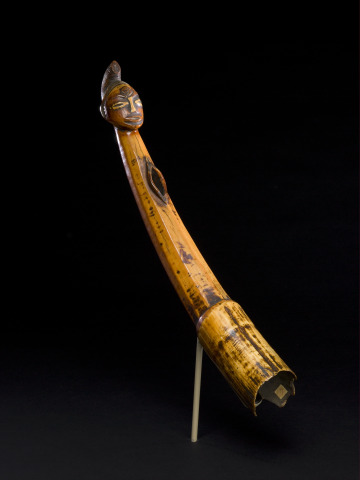Side-Blown Horn (pungi)
- Artist Culture
- Punu artist
- Date
- late 19th century
- Material
- Elephant ivory
- possibly associated with
- Nyanga province, Central Africa, Gabon, Africa
Ngounié province, Central Africa, Gabon, Africa - Classification
- Ivories, musical instruments
- Current Location
- On View, Gallery 117
- Dimensions
- 17 x 3 1/2 x 2 in. (43.2 x 8.9 x 5.1 cm)
- Credit Line
- Museum Purchase
- Rights
- Contact Us
- Object Number
- 203:1942
NOTES
The material prestige of an ivory trumpet such as this one reinforced the solemnity of any ceremony at which it sounded. Across equatorial Africa, ivory was a precious material strictly controlled by chiefs and kings. Repeated handling and applications of palm oil have resulted in the deep red-orange color of this horn’s surface. The trumpet finial features the likeness of a Punu "mukudj" mask representing an idealized woman. "Mukudj" masks were associated with the Okuyi society, who performed in funerary contexts for individuals of rank, as well as male initiations and public hearings, suggesting this instrument’s appearance at those events. Punu side-blown trumpets carved from ivory are exceedingly rare, as those attributed to the group are more commonly made of antelope horn rather than ivory.
Provenance
- 1942
R. Stora, New York, NY, USA
1942 -
Saint Louis Art Museum, purchased from R. Stora [1]
Notes:
[1] An invoice dated November 24, 1942 from R. Stora to the City Art Museum documents the purchase of this object, listed as "No. 71 Ivory Horn or Olifant, cut cantwise ended by a woman's head, high depressed hair, dark red patina" [SLAM document files]. Minutes of the Administrative Board of Control of the City Art Museum, December 9, 1942.
R. Stora, New York, NY, USA
1942 -
Saint Louis Art Museum, purchased from R. Stora [1]
Notes:
[1] An invoice dated November 24, 1942 from R. Stora to the City Art Museum documents the purchase of this object, listed as "No. 71 Ivory Horn or Olifant, cut cantwise ended by a woman's head, high depressed hair, dark red patina" [SLAM document files]. Minutes of the Administrative Board of Control of the City Art Museum, December 9, 1942.

